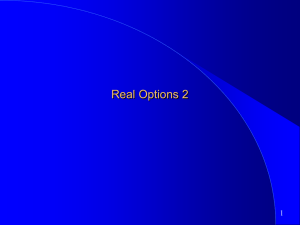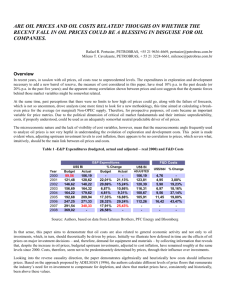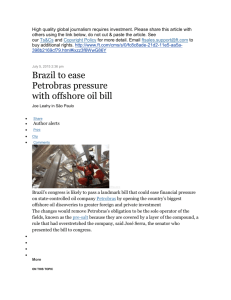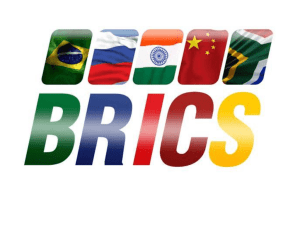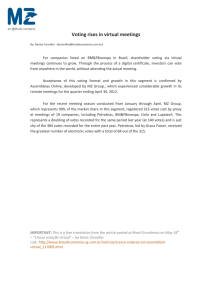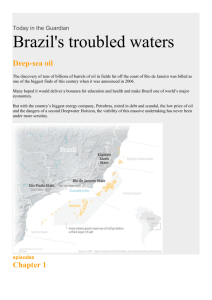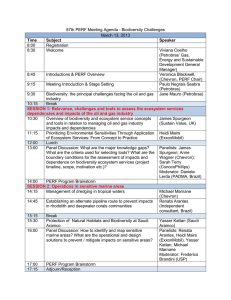Review of Brazil's National Oil Company
advertisement
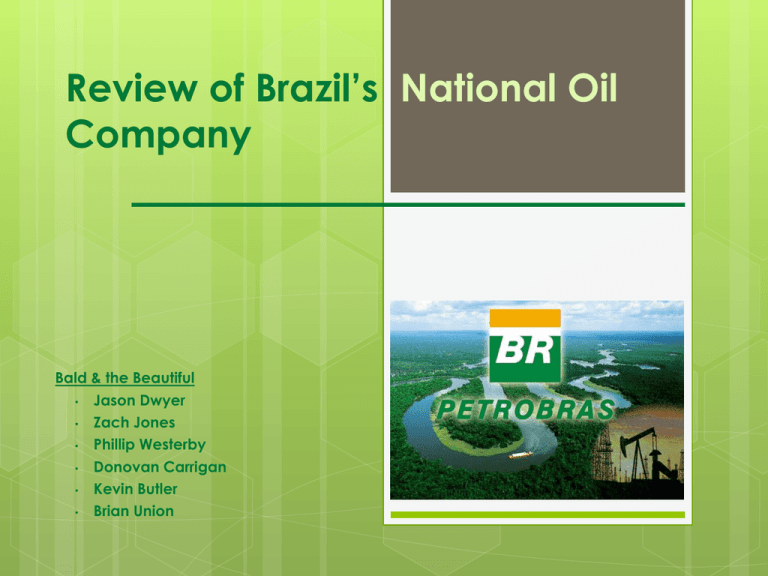
Review of Brazil’s National Oil Company Bald & the Beautiful • Jason Dwyer • Zach Jones • Phillip Westerby • Donovan Carrigan • Kevin Butler • Brian Union Agenda & Introduction Jason Dwyer Agenda • • • • • • • • • Summary Introduction The Strategy for Success Organizing the Downstream Developing the Offshore Deregulation The Principal’s Perspective The Agent’s Perspective Conclusions Questions Summary Introduction • • • • • • Created in 1954 as a Brazilian monopoly in the oil industry Core goal was to “Save scarce hard currency and provide a competitive, secure fuel supply for the industrialization of Brazil” Petrobras unlike most NOC’s was not created to be a source of government revenues Relied on government subsidies for first 20 years Started with no meaningful resources or expertize in producing, refining or marketing petroleum products In the early years the main job was to manage the countries growing oil imports Summary Introduction • • • • • • Seen by other NOC’s and IOC’s as a well managed and efficient industry leader Used Brazilian monopoly to lower finicial and operational risks of new technology most IOCs would not take on Changed over the years from reliance on partnership capabilities to development of in-house expertise World leader in deep water exploration & production Relatively small but growing presence abroad Organized vertically and oriented to exploit economies of scale Summary Introduction • • • • • • • • Prior to 1974 Campos Basin discovery, Petrobras organized the downstream infrastructure need to deliver oil to consumers Gentle slope of Campos basin allowed for gradual advancement of technology as they moved further offshore Shallow water success funded progressively deeper water development Future plans to build large domestic refineries to supply oil products overseas Largest publicly traded company in Latin America. Market value grew from $26.4B in 2000 to $173.6B in 2009 with $331.6B in assets by 2012 Will invest $224.7B in the next 5 years including $11.2B overseas Reserves of 12.8B BOE as of 12/31/2012 Summary Introduction • • • • • • • Domestic monopoly removed in 1997 as a part of broader market reforms to allow foreign investors Remained a de facto monopoly due to domination of upstream technology, logistics and managerial capabilities as well as downstream infrastructure Brazilian government still has a majority of shares in Petrobras Used offshore capabilities to form international partnerships with willing IOCs Suffered significant losses in Bolivia when assets were nationalized by Morales May 1, 2006 Petrobras operated in 46% of Bolivian oil reserves and accounted for 18% of the Bolivian GDP (24% of industrial taxes) Agreement on October 28, 2006 gave Petrobras 18% of profits and Bolivian government the rest Summary Introduction • • • • • • • • 1997 strategy centered around increasing production while remaining dominant in Brazil and expanding overseas opportunities 2008 Brazil reached self sufficiency and began exporting oil Petrobras plans to expand production to 6.4 million barrels a day by 2020 Discovery of the Pre-Salt opens a new era for Brazil Political changes have turned to oil for public revenues Government is wary of Petrobras becoming a state within a state Petrossal was formed as a government agency that will have a minimum 30% investment in all Pre-Salt oil exploration, development and production Societal fund will be created to manage the governments take Strategy for Success Zach Jones The Strategy for Success (State Monopoly) • • • • • • Brazil’s first oil concessions date to the Imperial period, but no significant inroads into oil industry until the 20th century 1930’s revolution (military and urban middle class alliance) ushered in a greater focus on oil as a means of substituting local production for imports Post-revolution economic model favored industrialization and urbanization, thereby increasing consumption of oil products 1934 Constitution established first ever property and mineral rights 1937 Constitution assigned those rights solely to Brazilian citizens or Brazilian companies 1938 decree gave federal gov’t control over oil supply The Strategy for Success (State Monopoly) • • • • • In addition to property/mineral rights, gov’t also established the Service for Promotion of Mineral Production (SFPM), later replaced by the National Petroleum Council (CNP) SFPM and CNP were designed to supervise, regulate and carry out all oil industry activities CNP’s initial exploration was focused on the sedimentary basin of Bahia Initial exploration relied on external experts who were essential, yet disposable when their decisions didn’t align with national interests 1940 decree taxed all oil by-products (foreign and domestic) and revenues used to further develop the oil industry The Strategy for Success (State Monopoly) • • • • Post-WWII gov’t of General Dutra allowed international companies to organize operations to explore oil and mineral resources 1948 – Strategy conflict arose between those favoring IOC partnerships and those with more nationalistic desires Gridlock ensued, resulting in failure of a bill allowing IOCs to invest in the oil business 1951 new gov’t bill on oil policy that initiated the creation of Petrobras in 1954 as the state-owned monopoly in charge of exploiting oil resources Organizing the Downstream Phillip Westerby Organizing the Downstream (1954-73) • • • • • • • Petrobras was formed as a state owned monopoly in 1954 by the Brazilian government. Exploration, production, transportation, and refining of all hydrocarbons in the Brazilian market. Brazil’s oil activities restricted to transportation, refining and marketing (downstream) Refining capacity under construction was less than 50% of domestic consumption Available tankers could transport only 20% of necessary imports Domestic oil production only 2.5% of domestic consumption All led to focus on frugality and restraints domestically Organizing the Downstream (1954-73) • Petrobras’ management primarily former military • • Petrobras’ goals were set by the government • • • • Employees well educated abroad & “foreign experts” Find domestic oil resources Develop downstream infrastructure to supply domestic consumption Envisioned as a single, large, vertically-integrated organization. The Government provided “generous” financial incentives • • • • Exemptions included on import duties, royalties Tax relief on equipment Petrobras to retain 80% of “savings” resulting from domestic supply Petrobras allowed to put away funds deemed necessary to fund domestic supply (“oil account”) Organizing the Downstream (1954-73) • Continued Political Pressures (nationalists vs internationalists) • • • • • “not doing enough to meet national goals” Government sided with Petrobras in political disputes Lack of significant land based oil resources discovered despite substantial drilling efforts Government nationalized all remaining refineries to Petrobras Military Coup of 1964 • • • • • • Established new military government Sold nationalized refineries back to IOC’s that previously owned them Removed Petrobras’ monopoly over shale oil Allowed private investments in petrochemicals (internationalists) Petrobras’ oil monopoly was preserved (nationalists) New Goal = “to find the oil demanded by the economy in such way that the expenditures of foreign currency would not increase” Organizing the Downstream (1954-73) • New Military Government • • • Less Transparent, less public oversight Hierarchical General Ernesto Geisel becomes Petrobras’ President (1968) • • • • Enlarged autonomy of Petrobras with agreement not to permit oversight by Minister of Mines and Energy Mission “to guarantee the domestic supply of oil products” Did not believe results of Link report were correct Search for oil to go overseas and offshore Organizing the Downstream (1954-73) • General Geisel’s Petrobras • Ultimate strategy was to focus on downstream • • To support new downstream focused strategy • • • • Take advantage of falling international oil prices to lower prices to domestic consumers. Relied on cash flow from domestic oil production and European bank loans Adopted strict Quality procedures for equipment procurement and services Forced domestic suppliers to improve economic competitiveness Geisel’s Downstream Strategy Risks • If oil discovered overseas, oil-sufficiency objective could be jeopardized • If new domestic oil was more expensive than other markets, Petrobras would depend on additional government incentives (subsidies) – not guaranteed. • Risks were high for Brazil, but relatively small for Petrobras. Developing the Offshore Donovan Carrigan Developing the Offshore • Low emphasis on domestic production • • • Intense capital investments for industrial projects • • • In 1974, 80% of oil consumed was imported 1973 oil crisis and price escalation Incentives to domestic suppliers of capital goods Government thought these capital projects would later save foreign currency Crude imports increased from $1B to $4.9B from 1972 to 1974 • • Nuclear power and hydropower Increased taxation on gasoline • • Taxes remained low for oil products (diesel) used for building industrial infrastructure Increased use of alcohol fuels Developing the Offshore • Government influence • • • Early offshore success • • • • Guaricema field (1969) Long shoreline had geological potential Garoupa and Pargo field found in the Campos Basin (1974) IOC entry • • • • Pushed Petrobras to find domestic oil Known amounts of onshore oil were modest Petrobras had limited technology Strong interest by IOCs Difficult for Petrobras to share findings Business strategy (Petrobras vs. IOCs) • • President General Geisel mandated that Petrobras agree to service contracts with IOCs IOCs to absorb the risk Developing the Offshore • Changed investment strategy to focus on upstream • • By 1979, 50% of Petrobras’ investments were for exploration and production, up from 25% in 1970 Progressively moving from shallow to deep water (Campos Basin) • • • Using a stepwise approach allowed Petrobras to improve technology rapidly Discovery of large reservoirs in deep water Success in technology came from small incremental changes, using the Campos Basis as a R&D playground (Jack-up rigs and floating platforms) Developing the Offshore • Economic and political instability • • • General Figueiredo takes office in 1979 Rising interest rates and economic contraction in the early 80’s In1980, oil rises to an all time high • • Reduction of oil imports • • • • • Government objective to produce 500,000 bpd by 1985 From 1975 to 1980 IOCs invested $1.2B • • Brazil was importing 84% of their oil Unable to find sufficient oil IOCs blamed Petrobras, Petrobras blamed IOCs Brazil trapped between unstable debt payments and macroeconomics Government introduces stabilization plans Ministry of Finance takes control over pricing Deregulation Kevin Butler Deregulation 1995-2008 • • • • Transition to a full Democracy was complete in 1989 President Cardoso elected in1994 Cardoso’s platform was to fix the country’s economic situation Cardoso’s initiatives were: • • • ”Plano Real” control the country’s inflation. Liberalization - which was to reduce subsidies, promote operating transparency & improve the government’s ability to increase tax revenues Privatization - goal was to attract foreign investors and foster competition. Deregulation 1995-2008 • • Fully privatizing Petrobras was abandoned due to political pressure from the Nationalist The government did start the liberalization of the oil market by: • • • The APN’s main functions were: • • • • Retaining the right to allocate concessions for exploration blocks Creating the National Petroleum Agency (ANP) Managing the auctioning off of exploration block Contract the licensing of exploration Regulate upstream & downstream activities across the oil sector Main driver towards aiding deregulation were disclosure reforms. Key goals: • • • Expose Petrobras to competition Increase fiscal transparency Attract IOC’s to the Brazilian hydrocarbons market Deregulation 1995-2008 • Deregulation - Government Point of View • • • • Deregulation - Petrobras Point of View • • • • • Guaranteed it’s oversight over exploration & production of oil companies operating in Brazil Increased the flow of oil benefits to the Treasury Decreased bureaucracy between Petrobras and the government Removed governmental control of pricing for oil products The government allowed Petrobras to safeguard its assets Petrobras could invest it’s revenues in new production Petrobras could behave as an IOC Deregulation - IOC’s Point of View • • IOC’s could invest in Brazil with clear knowledge of financial impacts IOC’s could partner with Petrobras, taking advantage of Petrobras’ deep understanding of the Brazilian market Perspectives & Conclusion Brian Union The Principal’s Perspective • The “principal” – Brazilian Government • • • • • Expects Petrobras to achieve government objectives • • • • Political demands vs. financial returns Grants the right for Petrobras to explore the oil resources In 2008 Brazil reached self sufficiency of oil and is now a net exporter A new era with Petrobras “Petrossal & Pre-Salt field discoveries” To save scarce hard currency Provide a competitive, secure fuel supply for the industrialization of Brazil Preferences were designed to align with those of the government – least risky activities Struggles to set & enforce goals that encourages Petrobras to behave in different ways • • • Petrobras becoming a “state within a state” Asymmetric structure is a major difficulty for finding a fair deal between the government and Petrobras Petrobras “huge” informational advantage The Principal’s Perspective • Petrossal • • • • • Chief role is in the development and marketing of the oil resources Fully owned by the Brazilian government and acts as a administration that will enforce the government policy for the oil sector Subordinates Petrobras to governmental policies while making them responsible for the financial & operational risks Government hopes Petrossal will reduce the asymmetry of information between state and Petrobras Objective of this new “strategy” • • • • Shift the behavior of the “agent” in line with government’s new preferences Strategic role of oil supply in the foreseeable future Dramatic increase in oil revenues that can be used to promote political legitimacy Social objective (fight poverty, promote innovation, etc) The Agent’s Perspective • The “agent” - Petrobras • • • Effects of the 1970s oil crisis • • • • • Created to coordinate the development of the incipient Brazilian oil market Initially focused on least risky activities most aligned w/ government goals (downstream) First sign of distance between the government and Petrobras Oil imports reemerged as a major constraint to industrialization, a critical problem for the political legitimacy of the military government Geisel public demand to open the Brazilian oil market to IOCs Petrobras responds to new market conditions with IOCs Monopoly effects - “state within a state” • • • Guaranteed market for any domestic oil produced by the company Encouraged foreign suppliers to share the risks and benefits of the development of new offshore technologies Organized itself to identify the most promising technologies and integrate those technologies into the firm The Agent’s Perspective • The 1990 liberalization of the Brazilian economy • • • • • • Petrobras remained a de facto monopolist in the downstream arena Dominated the upstream market through its ability to select for itself the blocks where it would hunt for oil Used its large asymmetry of information (geological, technological, industrial, and political) to effectively compete with IOCs Reorganized its structure to operate as business units, each one rewarded on the basis of it performance Continued investments into new technology – “Procap 2000” Petrobras Today • • • Petrobras has move its offshore operations further into deep waters, finding extremely promising oil province in the “Pre-Salt” This game changing development further distances the set of preferences of government from that of Petrobras Overseas operations have increased thus creating an environment for Petrobras to operate under less governmental constraints Conclusion • • • • • • • • • • • • • • Created in 1954 as a Brazilian monopoly in the oil industry Petrobras unlike most NOC’s was not created to fund the government Changed over the years from reliance on partnership capabilities to development of in-house expertise World leader in deep water exploration & production Largest publicly traded company in Latin America. Will invest $224.7B in the next 5 years including $11.2B overseas Reserves of 12.8B BOE as of 12/31/2012 Domestic monopoly removed in 1997 as a part of broader market reforms to allow foreign investors (still De Facto) 2008 Brazil reached self sufficiency and began exporting oil Petrobras plans to expand production to 6.4 million barrels a day by 2020 Discovery of the Pre-Salt opens a new era for Brazil Political changes have turned to oil for public revenues Petrossal was formed as a government agency that will have a minimum 30% investment in all Pre-Salt exploration, development and production Societal fund will be created to manage the governments take Questions
